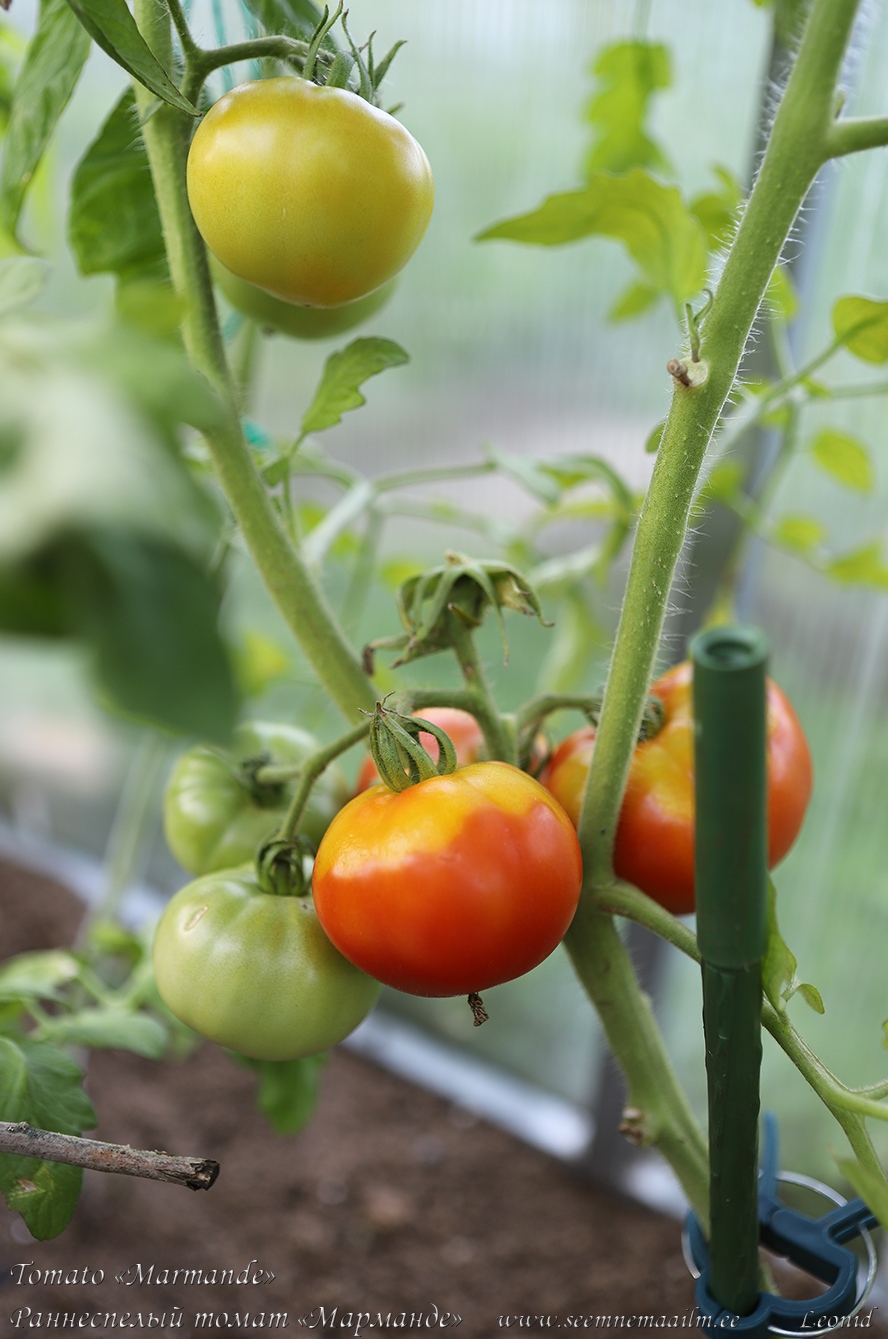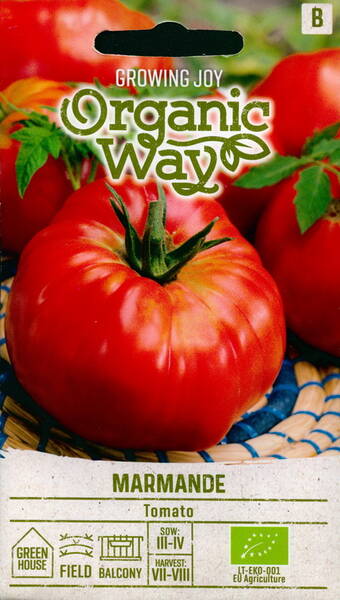An early, semi-determinate variety (the growing season is 70-75 days or from germination to maturity: 110-115 days).
Fleshy fruits, very tasty, weighing 150-170 g.
Fertile variety, fruits are large, with thin skin, and very tasty. Particularly suitable for fresh Caesar salad with feta cheese and olives. This variety of tomatoes needs support. Grown in greenhouses, on a hot summer outdoors. Select a sunny place protected from the winds for cultivation.
1,0 g = 300-400 seeds.

* Care of tomatoes.
Tomatoes are watered regularly (if there is no rain) - abundantly once a week. Row spacings are loosened after watering. With irregular watering, especially in dry weather, the fruits develop apical rot and crack.
They begin to feed no earlier than ten days after planting the seedlings. At first, they give a solution of mullein (a bucket of mullein for ten buckets of water), and preferably a solution of chicken manure (1/2 bucket for the same amount of water).
After feeding, the plants are spudded - undersized varieties with a solid ridge, tall ones - each plant separately. Hilling will cause the growth of additional roots, and increase nutrition, and this will prevent the ovary from falling off.
Subsequent feeding is carried out (depending on the state of the plants) every ten days with full mineral fertilizer (60 g of a garden fertilizer mixture) or 10 g of urea and potassium chloride and 40 g of superphosphate per 10 litres of water. Whoever has potassium sulfate, replace it with chloride in the same amount. You can also use a complex fertilizer with microelements (40 g per 10 l of water).
Before flowering, 1 litre of top dressing is applied under the plant, then 2 litres.
Top dressing must be combined with watering. If you notice that the leaves on the plants curl, temporarily exclude superphosphate from the feeding, and increase the dose of potassium and nitrogen fertilizers to 30 g per 10 litres of water. You can water the plants with boric acid or brown (2 g per 10 l of water), half a litre under the plant.
In the absence of mineral fertilizers, feed the plants with a solution of mullein or bird droppings, diluted eight to ten times with water, respectively. At the same time, it is good to add wood ash to the grooves around the plants, and half a glass under the plant. If the tops of the plants are large, and the flowering and fruit set is delayed, completely exclude nitrogen fertilizers (both organic and mineral) from fertilizing. With an excessive amount of nitrogen, the plants "fatten", which delays the setting and ripening of fruits, in addition, nitrates accumulate in them.
How to accelerate ripening?
This question is of particular interest to gardeners since everyone wants all the fruits that have been set to ripen on the bush. For this, plants first of all need to be properly formed. Tomatoes have the ability to branch strongly, from each bud located in the axil of a leaf on the main stem, a lateral shoot grows - a stepson. Removing these shoots is called pinching. If the plant is not pinned, then many shoots will form on it and each will have flower brushes. The more there are, the slower the fruits are formed and ripen. Pickling not only accelerates fruit ripening but also significantly increases the yield in the first harvest.
Stepson, the plants form into one, two, or three stems:
with a single-stem form on the main stem, remove all lateral shoots formed in the axil of each leaf;
with two-stem - remove all lateral shoots, with the exception of one growing directly under the first flower brush;
with a three-stemmed one - in addition to the stepson, one more of the lower, but the most powerful shoot is left under the first flower brush.
Plants need to be grazed systematically so that the stepchildren are no more than 4–5 cm long (it is better to remove them with scissors, leaving a "stump" 1 cm long, which will not allow a new shoot to quickly form in this place).
In addition to pinching, other techniques are also used that accelerate the setting and ripening of fruits, for example, foliar top dressing with superphosphate. Plants at the beginning of flowering of the first brush are sprayed with a 0.5% extract of superphosphate (50 g per 10 l of water). The superphosphate extract is prepared a day before use. The required amount is poured with hot water and mixed several times. The settled solution is drained before use.
Other techniques.
Pinching is the removal of the tops from fruiting shoots. It is carried out to restrict the growth of the plant, which will accelerate the formation and maturation of the set fruits. Pinching, depending on the zone, variety and weather, is carried out over the second, third and fourth brushes. It is of particular importance in tall, later-maturing varieties. Simultaneously with the pinching, all flower brushes are removed, on which the fruits still do not have time to form. Turning the fruits towards the sun significantly accelerates the ripening of the formed fruits. This applies mainly to undersized varieties. At the same time, dry and yellow leaves must be removed, and wooden spacers - slingshots - should be substituted under the brushes with fruits, or the brushes must be laid on the stem so that the fruits are illuminated by the sun and do not lie on the ground.
The longitudinal cut through the stem also accelerates fruit ripening. It is made 5–6 cm long at a height of 12 cm from the soil. A sliver (0.05 cm thick, 2 cm wide) is inserted into the cut, turn it to the wide side so that the walls of the stem move apart. Limiting the supply of food and moisture to the plant will accelerate the ripening of the fruits. To do this, grab the lower part of the stem with both hands and carefully pull the plant up. With torn roots, nutrition will be limited, which will also accelerate the ripening of fruits.
It is important not to carry out both the last receptions prematurely, as this will result in many small fruits that have not finished growing, which will reduce the yield. It is most advisable to remove all mature fruits from the bushes as brown (and even green or starting to turn white) and lay them for ripening. This will greatly speed up the filling of the fruits remaining on the bush, which will increase the yield.
Dosing is carried out in a well-ventilated room at + 20 + 25 ° C. At + 12 ° C, ripening is significantly slowed down, at ten and below, many fruits rot. Fruits are placed on shelves, shelves, and in boxes in no more than two or three layers. To accelerate ripening, several pieces of red are placed in boxes with green fruits. Ripe fruits emit ethylene gas, which accelerates fruit ripening.
If ripening needs to be delayed in order to prolong the consumption of fresh fruits, the boxes are looked through daily and the red fruits are selected from them.













